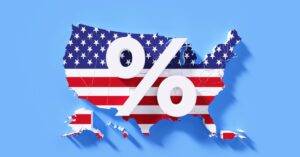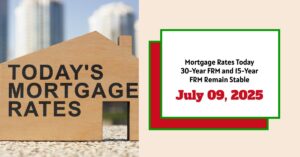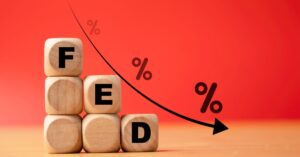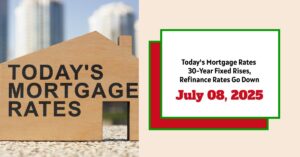As of Thursday, July 10, 2025, mortgage rates have experienced slight fluctuations, with 30-year fixed mortgage rates remaining steady at 6.81%, marking a 4-basis point increase from the previous week. Conversely, 15-year fixed mortgage rates have decreased and now stand at 5.84%. If you're considering either a new mortgage or refinancing your existing loan, it's crucial to stay updated on these rates as they can significantly impact your monthly payments and overall financial strategy.
Mortgage Rates Today – July 10, 2025: 30-Year FRM is Steady, 15-Year Rate Drops Slighty
Key Takeaways
- 30-Year Fixed Mortgage Rate: Currently at 6.81% (up 4 basis points).
- 15-Year Fixed Mortgage Rate: Currently at 5.84% (down 3 basis points).
- Total Refinancing Rate: Climbed to 7.06% for the 30-year fixed refinance option.
- Market Outlook: Rates expected to remain in the mid-6% range through 2025.
Understanding Mortgage Rates Today
Mortgage rates can often feel overwhelming, filled with terminology and numbers that are not immediately clear. However, understanding the basics can help demystify the process. According to data from Zillow, the national average 30-year fixed mortgage rate on July 10, 2025, stands at 6.81%. This is a 4-basis point increase compared to the previous week's rate of 6.77%.
Comparison of Current Mortgage Rates
Let's break down the current mortgage rates by loan type to better understand the landscape. The following table exhibits the conforming loan rates and their weekly changes:
| Loan Program | Current Rate | 1-Week Change | APR | 1-Week APR Change |
|---|---|---|---|---|
| 30-Year Fixed Rate | 6.81% | Up 0.04% | 7.25% | Up 0.03% |
| 20-Year Fixed Rate | 6.25% | Down 0.09% | 6.53% | Down 0.17% |
| 15-Year Fixed Rate | 5.84% | Down 0.04% | 6.13% | Up 0.03% |
| 10-Year Fixed Rate | 5.78% | Up 0.17% | 5.98% | Up 0.22% |
| 7-Year ARM | 7.82% | Up 0.48% | 8.27% | Up 0.49% |
| 5-Year ARM | 7.87% | Up 0.27% | 8.09% | Up 0.11% |
This table illustrates a trend where most fixed rates have shown minor fluctuations. Specifically, while the 30-year fixed rate has risen slightly, the 20-year fixed rate has seen a decline.
Government Versus Conforming Loan Rates
It's also important to distinguish between conforming loans and government loans. Conforming loans are those that meet specific guidelines set by Fannie Mae and Freddie Mac, which makes them eligible for purchase by these entities. These loans generally have stricter credit requirements and guidelines. On the other hand, government loans, including FHA and VA loans, are backed by the federal government, making them accessible to a wider range of borrowers, especially those with lower credit scores or limited cash for a down payment.
| Loan Type | Current Rate | 1-Week Change |
|---|---|---|
| 30-Year Fixed Rate FHA | 6.87% | Up 0.10% |
| 15-Year Fixed Rate FHA | 5.25% | Down 0.13% |
| 30-Year Fixed Rate VA | 6.21% | Down 0.08% |
| 15-Year Fixed Rate VA | 5.73% | Down 0.06% |
In this table, we can observe that while FHA loan rates have climbed, VA loan rates have seen a slight decrease, reflecting the varying trends in the market.
Refinance Rates Overview
For those already holding mortgages, refinancing might be a consideration, especially if current rates result in lower monthly payments. The current average 30-year fixed refinance rate has nudged up to 7.06%, marking a 2-basis point increase from 7.04% last week. Here’s a detailed look at the refinancing rates:
| Loan Program | Current Refinance Rate | 1-Week Change | APR | 1-Week APR Change |
|---|---|---|---|---|
| 30-Year Fixed Rate | 7.06% | Up 0.02% | 7.25% | Up 0.03% |
| 15-Year Fixed Rate | 5.91% | Up 0.03% | 6.13% | Up 0.03% |
| 5-Year ARM | 8.04% | Up 0.01% | 8.09% | Up 0.11% |
These figures reveal that refinance options are increasingly becoming more expensive, particularly for long-term loans.
Related Topics:
Mortgage Rates Trends as of July 9, 2025
Mortgage Rates Predictions for the Next 30 Days: July 3-August 3
Mortgage Rate Predictions for the Next 3 Years: 2026, 2027, 2028
Market Outlook for Mortgage Rates
Looking ahead, experts predict that mortgage rates will hover within the mid-6% range until the end of 2025 unless significant shifts occur in the economy. The Federal Reserve has indicated they will not make substantial rate cuts until inflation approaches 2.0%, a benchmark unlikely to be achieved before 2027.
Prominent forecasting agencies and analysts are cautiously optimistic but recognize the constant economic volatility. Notably, Fannie Mae anticipates mortgage rates to settle around 6.5% by the end of 2025, while the Mortgage Bankers Association expects rates to predominantly stay near 6.8%.
Why Are Rates Still High?
Several factors contribute to the persistently high mortgage rates observed in the current market. For example:
- Economic Uncertainty: Fluctuations in the Treasury yields directly impact mortgage rates. This week saw a brief decline, but overall, trends indicate stability rather than significant drops.
- Inflation Concerns: Persistent inflation continues to affect borrowers’ purchasing power, causing lenders to maintain higher rates as a safeguard.
- Homebuyer Demand: With over 75% of current homeowners locked into fixed rates below 6%, there is limited market supply, exacerbating the affordability crisis for new buyers.
Summary
As we assess the current mortgage rates today, July 10, 2025, it's essential to remain informed of slight changes and trends in the market. Understanding the distinctions between different loan types, potential refinancing options, and the broader economic context can empower borrowers to make more informed decisions about their housing finance options.
Invest Smarter in a High-Rate Environment
With mortgage rates remaining elevated this year, it's more important than ever to focus on cash-flowing investment properties in strong rental markets.
Norada helps investors like you identify turnkey real estate deals that deliver predictable returns—even when borrowing costs are high.
HOT NEW LISTINGS JUST ADDED!
Connect with a Norada investment counselor today (No Obligation):
(800) 611-3060
Also Read:
- Will Mortgage Rates Go Down in 2025: Morgan Stanley's Forecast
- Mortgage Rate Predictions 2025 from 4 Leading Housing Experts
- 30-Year Fixed Mortgage Rate Forecast for the Next 5 Years
- 15-Year Fixed Mortgage Rate Predictions for Next 5 Years: 2025-2029
- Will Mortgage Rates Ever Be 3% Again in the Future?
- Mortgage Rates Predictions for Next 2 Years
- Mortgage Rate Predictions for Next 5 Years
- Mortgage Rate Predictions: Why 2% and 3% Rates are Out of Reach
- How Lower Mortgage Rates Can Save You Thousands?
- How to Get a Low Mortgage Interest Rate?
- Will Mortgage Rates Ever Be 4% Again?










